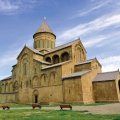SVETITSKHOVELI CATHEDRAL
Unesco World Heritage Cathedral with several royal tombs.
It is exceptional. It is an architectural masterpiece, and symbolically and spiritually the site is also unique, as the cathedral is one of the last witnesses to the kingdom of Kartli (3rd-5th century). The architecture of the present monument, reconstructed on top of buildings dating from the 5th century, dates back to the 11th century. It reflects the extreme refinement of medieval art of the time. The building still preserves much older remains, such as mural frescoes dating back to antiquity. Classified as a UNESCO World Heritage Site like the other monuments of Mtskheta, the cathedral reflects the high level of culture, art and social, political and economic development achieved by the Kingdom of Kartli and its impact on its region. It should be remembered that Christianity was introduced to Georgia here. From here, the new religion was spread and flourished throughout the country. Svetitskhoveli, literally "life-giving column", is still the most sacred monument in Georgia. The cathedral takes its name from a very old legend. (Before visiting it, respect the instructions: women, even in trousers, must cover their legs and hair, avoid wearing sleeveless T-shirts, shorts are forbidden) The cathedral houses several tombs of sovereigns.
The story goes that the original monument is said to have been built in the 4th century, shortly after King Mirian's conversion to Christianity, according to the injunction of Saint Nino, the instigator of this conversion. The building, originally made of wood, was built over the site of the tomb of Saint Sidonia holding the shroud of Jesus Christ in her hands, brought from Jerusalem by Elias, who had acquired it from a soldier on Golgotha, according to a very old legend (read "Story of Saint Nino"). Destroyed regularly by successive invading armies over the centuries, the present monument was erected between 1010 and 1029. It was once the seat of the patriarchate before being transferred to Tbilisi for political reasons. Kings were crowned, married and buried there. In medieval times, the Church not only had a fundamental impact on the daily life of Georgians. It owned a great deal of land, which was the source of its wealth. Surrounded by walls, dating from the 18th century, restored during the reign of Heraclius II, the monument has a very beautiful appearance. It is surmounted by a green dome 54 m high, with a cruciform plan with three naves. You will first pass through the 11th century Bull Gate. It takes its name from two bull heads appearing on the wall. They are a symbol of fertility. The monument is so admirable that it is said that the ruler in power at Mtskheta was so jealous of the beauty of the cathedral that he had his architect's hand cut off.
If you visit the monument in an anti-clockwise direction, on the outside, along the west façade, a group of bas-reliefs depict St. George with eagles, vines and lions. The latter symbolize wealth and fecundity. The low walls in front of the wall are all that remains of side chapels destroyed by the Russians in the 19th century. The eastern facade is more richly decorated.three windows evoke the Holy Trinity.they are decorated with an eagle and a lion, representing the nobility and royal lineages. On the north wall, Jesus, the cross, an eagle and rays appear, perhaps representing the thirteen Assyrian fathers or Saint Nino. The hand holding the square would be the signature of the unfortunate architect.
Inside, on the left, you will see a rectangular basin serving as a baptismal font. King Mirian and his wife Nana were baptized there, followed by the baptism of successive rulers. The treasure would have been hidden in the upper parts. In the background on the right is a model of a 13th-century church that is said to have been built in Jerusalem by the Roman Emperor Constantine. The original edifice is said to have been built on the very site of Christ's crucifixion. On the left is the base of the famous living pillar, which originally gave the church its name, and which once supported the original wooden building. Further on, you will see the seat of the Catholicos. Saint Sidonia is still buried there. In the past there was a tree that would have grown on her grave. Columns are covered with frescoes, representing Constantine and his mother Helen around the cross, Jesus healing a sick person, Christ entering Jerusalem, the Annunciation, the Archangel Gabriel, the Holy Trinity, Abraham... You will also see the four evangelists. King Vakhtang Gorgassali, who built the church in stone, as well as thirteen other rulers are buried here. The frescoes on the wall to the right show Jesus in the middle of the twelve signs of the zodiac, a rather rare representation in Christian art. In the apse, at the back, the monumental fresco of Christ dates back to the 11th century. It is the most remarkable and the oldest. The other frescoes decorating the church were mostly executed during the 17th century. Two chapels dedicated respectively to Saint Elijah and Saint Nicholas stand side by side with the huge fresco. Thus, the church tells its entire history.


L'intérieur est sobre, mais bien décoré.